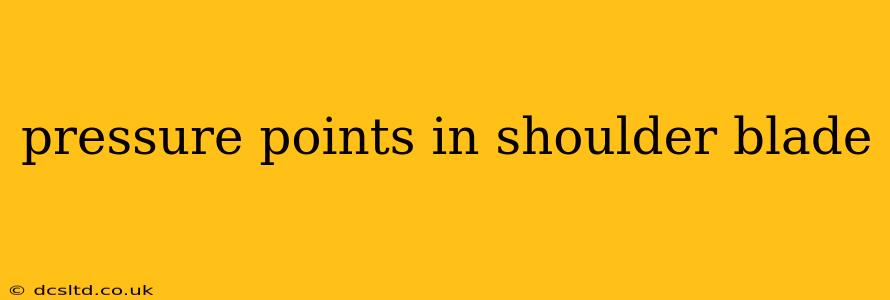The shoulder blade, or scapula, is a complex area with numerous muscles, nerves, and ligaments. Pain in this region can stem from various sources, often manifesting as localized pressure or discomfort in specific points. Understanding these pressure points can help pinpoint the underlying issue and guide effective treatment. This article will explore common pressure points in the shoulder blade, their causes, and how to alleviate the pain.
What Causes Shoulder Blade Pressure Points?
Shoulder blade pain isn't always caused by a single pressure point. It's often a symptom of a broader issue. Here are some common causes:
- Muscle Strain or Spasm: Overuse, poor posture, or sudden movements can strain the muscles surrounding the scapula, leading to tight knots and pressure points. Muscles frequently involved include the trapezius, rhomboids, and levator scapulae.
- Referred Pain: Pain originating from other areas, like the neck, heart, or lungs, can manifest as pressure or pain in the shoulder blade. This is referred pain and requires investigation to identify the primary source.
- Injury: Direct trauma to the shoulder blade, such as a fall or impact, can cause bruises, fractures, or other injuries leading to localized pressure points.
- Nerve Compression: Compressed nerves in the neck or shoulder can radiate pain to the shoulder blade, causing intense pressure or tingling sensations.
- Postural Problems: Prolonged poor posture, such as hunching over a computer, can strain the muscles and create pressure points in the shoulder blade.
- Medical Conditions: Conditions like fibromyalgia, osteoarthritis, and bursitis can cause chronic pain and pressure points in the shoulder blade.
Common Pressure Points in the Shoulder Blade and Their Associated Causes
While there aren't officially named "pressure points" in the shoulder blade in the same way as in traditional acupuncture, specific areas frequently experience pain and discomfort. These are often associated with the underlying causes mentioned above.
Upper Trapezius Pressure Point: This area, located at the top of the shoulder blade near the neck, often feels tight and knotted, particularly with prolonged computer use or stress. This pressure point often manifests as pain radiating up into the neck and head.
Rhomboid Muscle Pressure Point: This point lies between the shoulder blades, often causing a deep ache or stiffness. It is frequently associated with poor posture and muscle imbalances.
Levator Scapulae Pressure Point: Located at the inner top corner of the shoulder blade, near the neck, this pressure point can cause pain that radiates into the neck and shoulder. It’s often associated with stress and tension.
Infraspinatus/Teres Minor Pressure Point: These muscles, located on the back of the shoulder blade, can develop trigger points causing pain that radiates down the arm. This is often associated with rotator cuff issues.
How to Treat Shoulder Blade Pressure Points?
Treatment depends heavily on the underlying cause. However, several methods can offer relief:
- Massage: Professional massage therapy or self-massage can help release muscle tension and alleviate pressure points.
- Heat and Ice: Applying heat or ice packs can reduce inflammation and pain. Heat is often better for muscle stiffness, while ice is better for acute injuries.
- Stretching: Regular stretching exercises targeting the neck, shoulders, and back can improve posture and alleviate muscle tightness.
- Over-the-counter pain relievers: Ibuprofen or naproxen can help reduce pain and inflammation.
- Physical Therapy: A physical therapist can provide personalized exercises and treatments to address the underlying cause of the pain.
Preventing Shoulder Blade Pressure Points
Preventing shoulder blade pressure points involves addressing the root causes:
- Maintain good posture: Be mindful of your posture throughout the day, especially when sitting at a desk or driving.
- Regular exercise: Engage in regular exercise that strengthens the back and shoulder muscles, such as yoga, swimming, or weight training.
- Ergonomic workspace: Ensure your workspace is ergonomically designed to support good posture and reduce strain.
- Stress management: Practice stress-reducing techniques like meditation or deep breathing exercises.
When to See a Doctor?
If your shoulder blade pain is severe, persistent, or accompanied by other symptoms such as numbness, weakness, or fever, it's essential to seek medical attention. Your doctor can help determine the underlying cause of your pain and recommend appropriate treatment.
This information is intended for educational purposes only and should not be considered medical advice. Always consult a healthcare professional for diagnosis and treatment of any medical condition.
